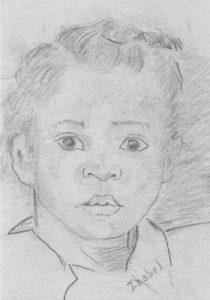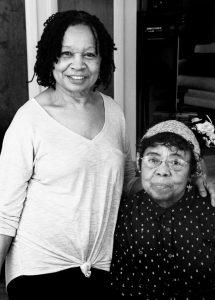On August 27, 1960 the Democrat and Chronicle reported “Twelve American Negroes, including one from Rochester, have been ordained Catholic priests this year, bringing the number of Negro priests in this country to 106.” Sixty years later, it’s a bit startling to see African-Americans referred to in such manner, but it was the term of the day.
The Rochester representative was Father Charles Hall, the oldest of 12 children born to Anthony and Mary (Estep) Hall. They lived on Clarissa Street, just a couple of doors south of Santiago, near where Charles had graduated from Immaculate Conception School and, along with his family, attended Immaculate Conception Church.
Roxana Weber & Isabelle WaltersTwo of his sisters, Roxana Weber and Isabelle Walters, remain members of the parish even though they no longer live in Corn Hill. During my visit with them, I gathered a lot of information about their brother and left with arms full of newspaper clippings, various papers, including a biography of Father Hall written by their mother, and numerous stories of a young man who, in his earliest years, did not seem destined for the priesthood.
Charles Anthony Hall was born in Maryland on July 23, 1931. A few years later, the family was living in Washington, D.C., where the young boy had his first experience attending school. He didn’t like it. When the teacher told him to wash his hands in a basin of water that had already been used by other boys, Charles came home and reported to his father, “That old teacher is crazy. She told me to wash my hands in dirty water!”
By 1938 the family had arrived in Rochester, living in homes on Favor and Ford Streets before settling, in 1944, at 546 Clarissa. As a student at Immaculate Conception, he started off well but became very indifferent by the fourth grade. He often complained of not feeling well and would stay home from school. He lost so much time that he had to repeat fourth grade. He wasn’t ill; he was distracted by a chemistry set and spending hours in the basement concocting experiments. One evening, his father said, “Charles, if you don’t stop playing with things in the basement, you’re going to blow this damned house up!”
After spending two years in fourth grade, he regained his focus. He excelled at sports and art and, during his senior year, appeared in a school play, acting the part of a priest. He performed so well that members of the audience thought he might go on to Hollywood. They clearly misinterpreted what they saw.
Shortly before his 8th grade graduation, Charles began working as a pinsetter in a local bowling alley. He would put aside some of his earnings to share it with homeless people. After enrolling at Aquinas Institute, he continued working at the bowling alley in the evenings and on weekends, using the money to pay his tuition.
chemist in the basementAccording to his mother, it was during junior year that he really blossomed. He served as vice-president of the student council and was active in the art club. One day a classmate told his mother that “Chuck” was going to be a priest. Mother thought it was a joke.
His sister Isabelle says he could have been anything he wanted to be. “He really was a renaissance man, multitalented, long before anyone knew about his religious avocation that was in the background.” She proudly showed off her brother’s artistic talent by sharing a drawing he made of her during his student days. Anthony Hall was a mason and, as a black man, often had trouble finding work. He hoped his son would go to college and become an architect. When Charles announced that he wanted to become a priest, it was very disappointing. His mother, realizing her son would move away from Rochester, felt sad as well.



It was a challenge even for Charles because most religious orders were not yet accepting candidates of color. Roxana recalls her brother’s decision to attend Epiphany College, a Josephite seminary in Newburgh, New York. “He wanted to help people but there was a lot of prejudice. That’s why he went to the Josephites.” It was a religious order with a long history in the black community.
Following the Civil War the archbishop of Baltimore, Maryland appealed to Rome for help in assisting thousands of recently freed slaves. Pope Pius IX responded by issuing what was called the Negro Oath, which became the basis for the Josephite order. Each priest had to “solemnly declare that I will make myself the father and servant of the Negroes; nor shall I ever take up any other work which might cause me to abandon, or in any way neglect the special care of the Negroes.” Long after the end of Reconstruction, Josephites continue to work within the black population.
On June 4, 1960, Father Charles Hall was ordained at the National Shrine of the Immaculate Conception in Washington, D.C., just seven months after the Shrine had been officially dedicated following 40 years of construction. On June 12, Fr. Hall offered his First Solemn Mass at Immaculate Conception in Rochester. Roxana was impressed when her brother was escorted down the aisle by a distinguished group of men. “To have the Knights of Columbus march in the processional was for me an inspiring affair. I personally had thought that the Knights of Columbus was a ‘White’ thing.”
frank hallAfter ordination, Fr. Hall was assigned to St. Augustine High School in New Orleans, where he taught chemistry. Two of his students soon won state (Louisiana) and national recognition for their scientific achievements.
This happy story ends quickly and tragically. In 1965, he was diagnosed with colon cancer. The next two years were spent in horrible pain as doctors, not properly trained for treating his cancer, put him through endless surgeries. Roxana is emphatic in her denunciation: “They butchered him.”
Less than seven years after his ordination, 36-year-old Fr. Charles Hall died March 25, 1967 on Holy Saturday morning during Easter weekend. He was buried in Holy Sepulchre Cemetery.
In 1973, two Baltimore schools (lower and middle) were named for him. In 1975, St. Francis Upper School added Charles A. Hall to its name. In 2010, the lower and middle schools were closed. The upper school seems to have reverted to its original name.
